Java平衡二叉树
gonghr 人气:0定义
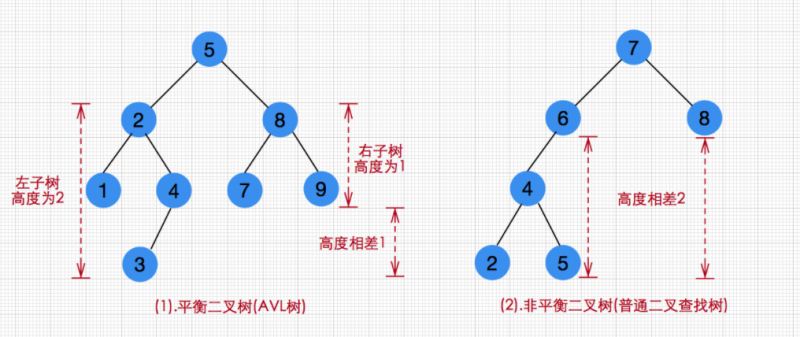
动机:二叉查找树的操作实践复杂度由树高度决定,所以希望控制树高,左右子树尽可能平衡。
平衡二叉树(AVL树):称一棵二叉查找树为高度平衡树,当且仅当或由单一外结点组成,或由两个子树形 Ta 和 Tb 组成,并且满足:
- |h(Ta) - h(Tb)| <= 1,其中 h(T) 表示树 T 的高度
- Ta 和 Tb 都是高度平衡树
即:每个结点的左子树和右子树的高度最多差 1 的 二叉查找树。
- 设 T 为高度平衡树中结点 q 的平衡系数为 q 的右子树高度减去左子树高度
- 高度平衡树所以结点的平衡系数只可能为:-1, 0, 1
结点结构

key:关键字的值
value:关键字的存储信息
height:树的高度(只有一个结点的树的高度为 1)
left:左子树根结点的的引用
right:右子树根结点的引用
class AVLNode<K extends Comparable<K>, V> {
public K key;
public V value;
public int height;
public AVLNode<K, V> left;
public AVLNode<K, V> right;
public AVLNode(K key, V value, int height) {
this.key = key;
this.value = value;
this.height = height;
}
}
查找算法
同二叉查找树的查找算法:Java数据结构之二叉查找树的实现
插入算法
AVL 树是一种二叉查找树,故可以使用二叉查找树的插入方法插入结点,但插入一个新结点时,有可能破坏 AVL 树的平衡性。
如果发生这种情况,就需要在插入结点后对平衡树进行调整,恢复平衡的性质。实现这种调整的操作称为“旋转”。
在插入一个新结点 X 后,应调整失去平衡的最小子树,即从插入点到根的路径向上找第一个不平衡结点 A。
平衡因子:该结点的左子树高度和右子树高度的差值。如果差值的绝对值小于等于 1,则说明该结点平衡,如果差值的绝对值为 2(不会出现其他情况),则说明该结点不平衡,需要做平衡处理。
造成结点 A 不平衡的的原因以及调整方式有以下几种情况。
LL 型
A 结点的平衡因子为 2,说明该结点是最小不平衡结点,需要对 A 结点进行调整。问题发生在 A 结点左子结点的左子结点,所以为 LL 型。
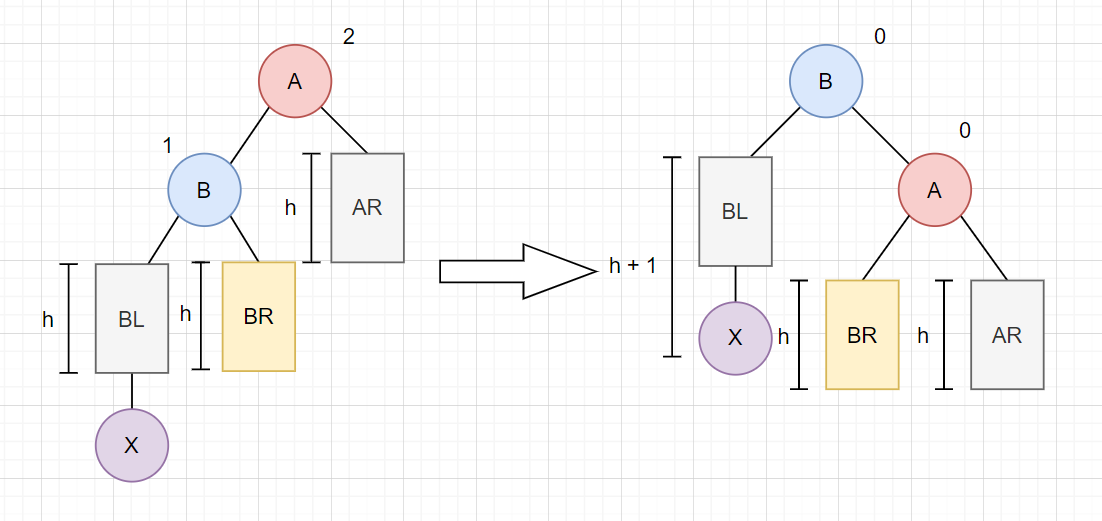
扁担原理:右旋
- 将 A 的左孩子 B 提升为新的根结点;
- 将原来的根结点 A 降为 B 的右孩子;
- 各子树按大小关系连接(BL 和 AR 不变,BR 调整为 A 的左子树)。
- 高度调整:由于调整后 B 的高度依赖于 A 的高度,所以先更新 A 的高度,再更新 B 的高度。
private AVLNode<K, V> rightRotate(AVLNode<K, V> a) {
AVLNode<K, V> b = a.left;
a.left = b.right;
b.right = a;
a.height = Math.max(getHeight(a.left), getHeight(a.right)) + 1;
b.height = Math.max(getHeight(b.left), getHeight(b.left)) + 1;
return b;
}
RR 型
A 结点的平衡因子为 2,说明该结点是最小不平衡结点,需要对 A 结点进行调整。问题发生在 A 结点右子结点的右子结点,所以为 RR 型。

扁担原理:左旋
- 将 A 的右孩子 B 提升为新的根结点;
- 将原来的根结点 A 降为 B 的左孩子;
- 各子树按大小关系连接(AL 和 BR 不变,BL 调整为 A 的右子树)。
- 高度调整:由于调整后 B 的高度依赖于 A 的高度,所以先更新 A 的高度,再更新 B 的高度。
private AVLNode<K, V> leftRotate(AVLNode<K, V> a) {
AVLNode<K, V> b = a.right;
a.right = b.left;
b.left = a;
a.height = Math.max(getHeight(a.left), getHeight(a.right)) + 1;
b.height = Math.max(getHeight(b.left), getHeight(b.left)) + 1;
return b;
}
LR 型
A 结点的平衡因子为 2,说明该结点是最小不平衡结点,需要对 A 结点进行调整。问题发生在 A 结点左子结点的右子结点,所以为 LR 型。

- 从旋转的角度:对 B 左旋,然后对 A 右旋
- 将 B 的左孩子 C 提升为新的根结点;
- 将原来的根结点 A 降为 C 的右孩子;
- 各子树按大小关系连接(BL 和 AR 不变,CL 和 CR 分别调整为 B 的右子树和 A 的左子树)。
private AVLNode<K, V> leftRightRotate(AVLNode<K, V> a) {
a.left = leftRotate(a.left); // 对 B 左旋
return rightRotate(a); // 对 A 右旋
}
RL 型
A 结点的平衡因子为 2,说明该结点是最小不平衡结点,需要对 A 结点进行调整。问题发生在 A 结点右子结点的左子结点,所以为 RL 型。

- 从旋转的角度:对 B 右旋,然后对 A 左旋
- 将 B 的左孩子 C 提升为新的根结点;
- 将原来的根结点 A 降为 C 的左孩子;
- 各子树按大小关系连接(AL 和 BR 不变,CL 和 CR 分别调整为 A 的右子树和 B 的左子树)。
private AVLNode<K, V> rightLeftRotate(AVLNode<K, V> a) {
a.right = rightRotate(a.right);
return leftRotate(a);
}
插入方法
根结点默认高度为 1
某结点的左右子树高度差的绝对值为 2,则需要进行平衡处理
I.左子树高
key 小于 root.left.key:LL型,进行右旋
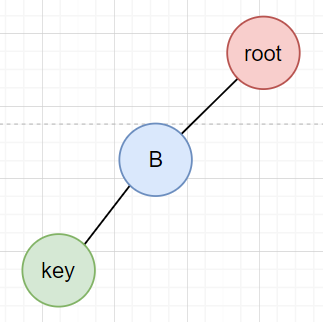
key 大于 root.left.key:LR型,进行左右旋
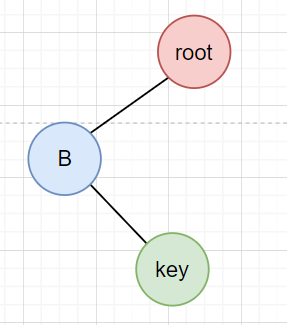
II.右子树高
key 大于 root.right.key:RR型,进行左旋
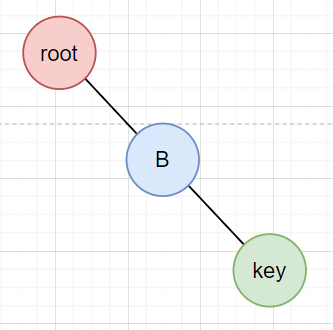
key 小于 root.right.key:RR型,进行右左旋

public void insert(K key, V value) {
root = insert(root, key, value);
}
private AVLNode<K, V> insert(AVLNode<K, V> t, K key, V value) {
if (t == null) {
return new AVLNode<>(key, value, 1);
} else if (key.compareTo(t.key) < 0) {
t.left = insert(t.left, key, value);
t.height = Math.max(getHeight(t.left), getHeight(t.right)) + 1;
// 平衡因子判断
if (getHeight(t.left) - getHeight(t.right) == 2) {
if (key.compareTo(root.left.key) < 0) // 左左:右旋
t = rightRotate(t);
else // 左右:先左旋,再右旋
t = leftRightRotate(t);
}
} else if (key.compareTo(t.key) > 0) {
t.right = insert(t.right, key, value);
t.height = Math.max(getHeight(t.left), getHeight(t.right)) + 1;
// 平衡因子判断
if (getHeight(t.left) - getHeight(t.right) == -2) {
if (key.compareTo(root.right.key) > 0) // 右右:左旋
t = leftRotate(t);
else // 右左:先右旋,再左旋
t = rightLeftRotate(t);
}
} else {
t.value = value;
}
return t;
}
删除算法
概述
- 可采用二叉查找树的删除算法进行删除。Java数据结构之二叉查找树的实现
- 删除某结点 X 后,沿从 X 到根节点的路径上考察沿途结点的平衡系数,若第一个不平衡点为 A,平衡以 A 为根的子树。
- 平衡后,可能使子树 A 高度变小。这样可能导致 A 的父节点不满足平衡性。
- 所以要继续向上考察结点的平衡性,最远可能至根结点,即最多需要做
O(logn)次旋转。 - 对比“插入”操作:平衡 A 后,子树高度不变,A 子树以外的结点不受影响,即插入最多涉及
O(1)次旋转。
实例分析
下面举个删除的例子:
删除以下平衡二叉树中的 16 结点

16 为叶子,将其删除即可,如下图。
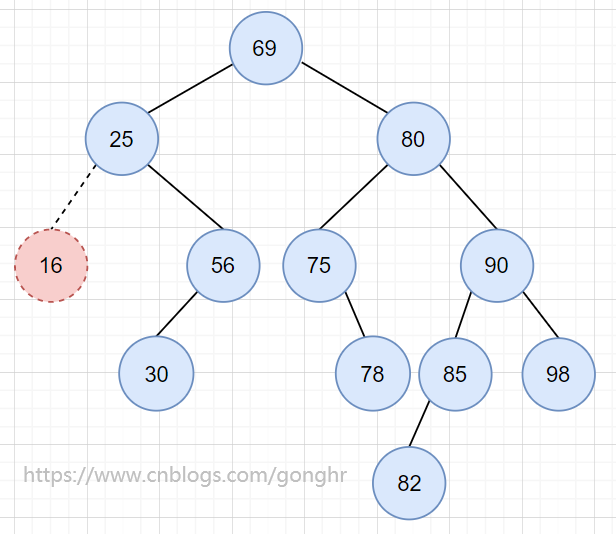
指针 g 指向实际被删除节点 16 之父 25,检查是否失衡,25 节点失衡,用 g 、u 、v 记录失衡三代节点(从失衡节点沿着高度大的子树向下找三代),判断为 RL 型,进行 RL 旋转调整平衡,如下图所示。
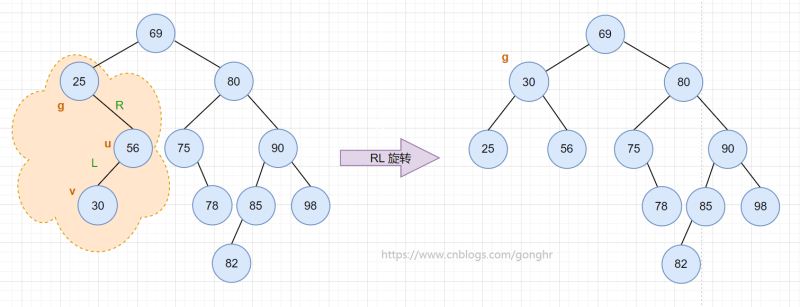
继续向上检查,指针 g 指向 g 的双亲 69,检查是否失衡,69 节点失衡,用 g 、u 、v 记录失衡三代节点,判断为 RR 型,进行 RR 旋转调整平衡,如下图所示。

代码
代码描述:
1.若当前结点为空, 则返回该节点
2.若关键值小于当前结点的关键值,则递归处理该结点的左子树
3.若关键值大于当前结点的关键值,则递归处理该结点的右子树
4.若关键值等于当前结点的关键值
- 若当前结点的左子树为空,则返回该结点的右子树根节点
- 若当前结点的右子树为空,则返回该结点的左子树根节点
- 若当前结点左右子树都不为空,则找到该结点的中序前驱结点(该结点左子树的最右结点)或中序后继结点(该结点右子树的最左结点),将其值赋予该结点,然后递归删除中序前驱或后继结点。
5.更新结点高度
6.若该结点左子树高度更高,且处于不平衡状态
- 若为 LL 型,进行右旋
- 若为 LR 型,先左旋,再右旋
7.若该结点右子树高度更高,且处于不平衡状态
- 若为 RL 型,先右旋,再左旋
- 若我 RR 型,进行左旋
8.返回该结点
public void remove(K key) {
this.root = delete(root, key);
}
public AVLNode<K, V> delete(AVLNode<K, V> t, K key) {
if (t == null) return t;
if (key.compareTo(t.key) < 0) {
t.left = delete(t.left, key);
}
else if (key.compareTo(t.key) > 0) {
t.right = delete(t.right, key);
}
else {
if(t.left == null) return t.right;
else if(t.right == null) return t.left;
else { // t.left != null && t.right != null
AVLNode<K, V> pre = t.left;
while (pre.right != null) {
pre = pre.right;
}
t.key = pre.key;
t.value = pre.value;
t.left = delete(t.left, t.key);
}
}
if (t == null) return t;
t.height = Math.max(getHeight(t.left), getHeight(t.right)) + 1;
if(getHeight(t.left) - getHeight(t.right) >= 2) {
if(getHeight(t.left.left) > getHeight(t.left.right)) {
return rightRotate(t);
} else {
return leftRightRotate(t);
}
}
else if(getHeight(t.left) - getHeight(t.right) <= -2) {
if(getHeight(t.right.left) > getHeight(t.right.right)) {
return rightLeftRotate(t);
}
else {
return leftRotate(t);
}
}
return t;
}
完整代码
class AVLNode<K extends Comparable<K>, V> {
public K key;
public V value;
public int height;
public AVLNode<K, V> left;
public AVLNode<K, V> right;
public AVLNode(K key, V value, int height) {
this.key = key;
this.value = value;
this.height = height;
}
}
class AVLTree<K extends Comparable<K>, V> {
public AVLNode<K, V> root;
public int getHeight(AVLNode<K, V> t) {
return t == null ? 0 : t.height;
}
public void insert(K key, V value) {
root = insert(root, key, value);
}
public void remove(K key) {
this.root = delete(root, key);
}
public AVLNode<K, V> delete(AVLNode<K, V> t, K key) {
if (t == null) return t;
if (key.compareTo(t.key) < 0) {
t.left = delete(t.left, key);
}
else if (key.compareTo(t.key) > 0) {
t.right = delete(t.right, key);
}
else {
if(t.left == null) return t.right;
else if(t.right == null) return t.left;
else { // t.left != null && t.right != null
AVLNode<K, V> pre = t.left;
while (pre.right != null) {
pre = pre.right;
}
t.key = pre.key;
t.value = pre.value;
t.left = delete(t.left, t.key);
}
}
if (t == null) return t;
t.height = Math.max(getHeight(t.left), getHeight(t.right)) + 1;
if(getHeight(t.left) - getHeight(t.right) >= 2) {
if(getHeight(t.left.left) > getHeight(t.left.right)) {
return rightRotate(t);
} else {
return leftRightRotate(t);
}
}
else if(getHeight(t.left) - getHeight(t.right) <= -2) {
if(getHeight(t.right.left) > getHeight(t.right.right)) {
return rightLeftRotate(t);
}
else {
return leftRotate(t);
}
}
return t;
}
private AVLNode<K, V> insert(AVLNode<K, V> t, K key, V value) {
if (t == null) {
return new AVLNode<>(key, value, 1);
}
if (key.compareTo(t.key) < 0) {
t.left = insert(t.left, key, value);
// 平衡因子判断
if (getHeight(t.left) - getHeight(t.right) == 2) {
if (key.compareTo(t.left.key) < 0) // 左左:右旋
t = rightRotate(t);
else // 左右:先左旋,再右旋
t = leftRightRotate(t);
}
} else if (key.compareTo(t.key) > 0) {
t.right = insert(t.right, key, value);
// 平衡因子判断
if (getHeight(t.left) - getHeight(t.right) == -2) {
if (key.compareTo(t.right.key) > 0) // 右右:左旋
t = leftRotate(t);
else // 右左:先右旋,再左旋
t = rightLeftRotate(t);
}
} else {
t.value = value;
}
t.height = Math.max(getHeight(t.left), getHeight(t.right)) + 1;
return t;
}
private AVLNode<K, V> rightLeftRotate(AVLNode<K, V> a) {
a.right = rightRotate(a.right);
return leftRotate(a);
}
private AVLNode<K, V> leftRightRotate(AVLNode<K, V> a) {
a.left = leftRotate(a.left);
return rightRotate(a);
}
private AVLNode<K, V> leftRotate(AVLNode<K, V> a) {
AVLNode<K, V> b = a.right;
a.right = b.left;
b.left = a;
a.height = Math.max(getHeight(a.left), getHeight(a.right)) + 1;
b.height = Math.max(getHeight(b.left), getHeight(b.right)) + 1;
return b;
}
private AVLNode<K, V> rightRotate(AVLNode<K, V> a) {
AVLNode<K, V> b = a.left;
a.left = b.right;
b.right = a;
a.height = Math.max(getHeight(a.left), getHeight(a.right)) + 1;
b.height = Math.max(getHeight(b.left), getHeight(b.right)) + 1;
return b;
}
private void inorder(AVLNode<K, V> root) {
if (root != null) {
inorder(root.left);
System.out.print("(key: " + root.key + " , value: " + root.value + " , height: " + root.height + ") ");
inorder(root.right);
}
}
private void preorder(AVLNode<K, V> root) {
if (root != null) {
System.out.print("(key: " + root.key + " , value: " + root.value + " , height: " + root.height + ") ");
preorder(root.left);
preorder(root.right);
}
}
private void postorder(AVLNode<K, V> root) {
if (root != null) {
postorder(root.left);
postorder(root.right);
System.out.print("(key: " + root.key + " , value: " + root.value + " , height: " + root.height + ") ");
}
}
public void postorderTraverse() {
System.out.print("后序遍历:");
postorder(root);
System.out.println();
}
public void preorderTraverse() {
System.out.print("先序遍历:");
preorder(root);
System.out.println();
}
public void inorderTraverse() {
System.out.print("中序遍历:");
inorder(root);
System.out.println();
}
}
方法测试
public static void main(String[] args) {
AVLTree<Integer, Integer> tree = new AVLTree<>();
tree.insert(69, 1);
tree.insert(25, 1);
tree.insert(80, 1);
tree.insert(16, 1);
tree.insert(56, 1);
tree.insert(75, 1);
tree.insert(90, 1);
tree.insert(30, 1);
tree.insert(78, 1);
tree.insert(85, 1);
tree.insert(98, 1);
tree.insert(82, 1);
tree.remove(16);
tree.preorderTraverse();
tree.inorderTraverse();
tree.postorderTraverse();
}
输出
先序遍历:(key: 80 , value: 1 , height: 4) (key: 69 , value: 1 , height: 3) (key: 30 , value: 1 , height: 2) (key: 25 , value: 1 , height: 1) (key: 56 , value: 1 , height: 1) (key: 75 , value: 1 , height: 2) (key: 78 , value: 1 , height: 1) (key: 90 , value: 1 , height: 3) (key: 85 , value: 1 , height: 2) (key: 82 , value: 1 , height: 1) (key: 98 , value: 1 , height: 1)
中序遍历:(key: 25 , value: 1 , height: 1) (key: 30 , value: 1 , height: 2) (key: 56 , value: 1 , height: 1) (key: 69 , value: 1 , height: 3) (key: 75 , value: 1 , height: 2) (key: 78 , value: 1 , height: 1) (key: 80 , value: 1 , height: 4) (key: 82 , value: 1 , height: 1) (key: 85 , value: 1 , height: 2) (key: 90 , value: 1 , height: 3) (key: 98 , value: 1 , height: 1)
后序遍历:(key: 25 , value: 1 , height: 1) (key: 56 , value: 1 , height: 1) (key: 30 , value: 1 , height: 2) (key: 78 , value: 1 , height: 1) (key: 75 , value: 1 , height: 2) (key: 69 , value: 1 , height: 3) (key: 82 , value: 1 , height: 1) (key: 85 , value: 1 , height: 2) (key: 98 , value: 1 , height: 1) (key: 90 , value: 1 , height: 3) (key: 80 , value: 1 , height: 4)
加载全部内容